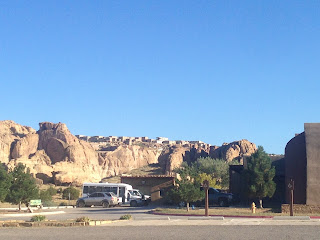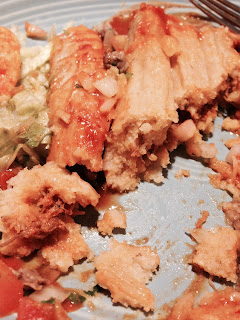 |
| Zuni Sun Face, a representation of the Sun-Father, one of the three main deities in Zuni religion |
The road to Albuquerque is a straightforward interstate freeway that would take about 2 hours to drive along from Gallup, but that sounded boring so we decide to head a little further south to take the old highway, Route 53, which has more historical significance. Whilst this way is still modern enough to drive along in comfort, it actually has roots that reach back into the 16th century and earlier as a exploratory trail for the Spanish.
 |
| Display in a local museum depicting the arrival of the Spanish and their Catholic missionaries. |
There is a heavy Spanish influence throughout New Mexico, something seen in the presence of Catholic missions hidden all the way out here in the pinon-juniper woodlands and desert. Our trip along Route 53 takes us through three layers of history - the most recent is the American history of the area, which dates back to 1848 (when America won the territory after the American-Mexican War). Prior to this is the Spanish history, when Nuevo Mexico was a province of New Spain. And before this is the indigenous history - of the Pueblo peoples (the Zuni and the Hopi), and the nomadic Apache and Navajo tribes.
Unlike the nomadic tribes of Native Americans, the Zuni and Hopi are settler peoples who built pueblos (cities). These mud and stone-brick buildings can be found all over America's South-West, some of which date back to the 13th century.
 |
| Zuni hornos. These are outdoor ovens that can be seen in the backyard of nearly every Zuni home. |
So we head a little further out of the way so that we can visit the Zuni Reservation, and drive through the shadow of their sacred Corn Mountain, a huge rocky outcrop that towers over the township and the flat lands that stretch beyond.
Our drive is a little confused at first; we reach the Zuni Information Centre and find it closed. A gas station attendant a few doors down, Charles, is a great help to us in checking the car over to make sure we haven't run it into the ground yet, and he spurs us on by telling us of the beauty of his culture and the reservation. He encourages us to keep driving on.
The township is quiet, and many of the stores have shut down. Photography permits are needed if we want to take photos of the restricted area of the town so we simply drive around a bit and observe the mud-brick buildings along the tight-knit network of dirt roads. The Zuni Reservation is the site of the largest of New Mexico's pueblos, but we are only able to see it from a distance at the bottom of a walled off hill within the community.
 |
| 'The Turquoise Village', a jewellery store in the Zuni Reservation |
A visit to one of the town's only open stores reveals that the tourist aspect of the town is well in decline. The owner of this business is philosophical and honest, explaining that the tastes of American tourists have changed in more recent times. In the 1990s, Zuni tourism was thriving and you could hire a guide to take you into the pueblo. Today, there just aren't enough visitors to support such an industry.
It's a real shame. Not because this means we can't go into the pueblo but because it means the people here have become financially isolated from the rest of the country. Haven't the Zuni been through enough? Not only did they have to survive American colonisation, before that they faced the full zeal and fervour of the Spanish - who came to the area to conquer and convert the Pueblan peoples to Catholicism whilst searching for the fabled Seven Cities of Gold.
Continuing on towards Albuquerque, we leave the reservation and re-enter American New Mexico - a territory marked by scarecrows in cornfields and late 19th century-styled cottages. We stop in the town of Ramah, where we don't see a single person. We get out to take a look at the local museum and Nicole shrieks as a cloud of locusts erupt around her. She quickly returns to the car after we realise the museum is closed.
 |
| Museum in Ramah |
By this point it's nearly 3 pm so we stop for lunch at a remote Navajo diner called La Tinaja. The menu is predominantly Mexican food, something I've been waiting for. The restaurant's host, Teresa, unabashedly tells us that the salsa comes from a bottle, but that it's also "the best bottled salsa you can buy". The food is great, exactly what we needed, but Teresa's service is the best thing about the place. She tells us about the local area and gives us a lollipop each for being good customers.
 |
| La Tinaja Restaurant |
 |
| Taquitos and green chili. |
 |
| Teresa and her perfectly preserved cash register |
Eating Mexican food reminds me how much I've missed fruit and vegetables. Getting fruit is really hard in America! Just this morning I was over the moon that our hotel offered apples for breakfast. Then I bit into one and had to chuck it away. Apples shouldn't be spongey.
 |
| El Morro |
Next stop is El Morro, another towering sandstone outcrop in the flat wilderness. This one has particular significance as a symbol of the layers of history in the area. As El Morro is also home to shaded pool of fresh water, it has been a stopover point for nearly every group in the area for at least a thousand years or more. The proof of this can be found in the form of inscribed graffiti all along the bottom of the sandstone outcrop.
 |
| Don Juan de Onate made this inscription in 1605 (a full fifteen years before any English settlers had landed in America). Onate was the Spanish Governor of Nuevo Mexico. |
 |
| Petroglyphs made by tribal people before European settlement. |
It's a pleasant walk, and the inscriptions are a fascinating insight into hundreds of years of history in the wider area.
 |
| Home along the roadside in Acoma. |
One more stop we take before we reach our destination is a trip into the Acoma Reservation. This diversion is taken on a whim and turns out to be the real highlight of the day. The car winds its way through hillsides covered in traditional stone and mud-brick buildings that are still inhabited, and a rather peaceful drive along a 16 mile road leads us to 'Sky City', an area named for a very special pueblo perched upon a mesa out in the desert.
 |
| View of Acoma Sky City from afar. Note the road leading towards it. |
Why is it so special? The pueblo is one of the oldest (if not the oldest) continuously inhabited places in the United States. It has been estimated that tribal people have lived in this pueblo for nearly 2000 years. Travel up into the pueblo is, of course, forbidden to tourists, but a view is allowed from just below the clifftop.
The view into this area, and the pueblo itself, feels and looks like a whole other country.
I know I've said things like this on my blog before, but it's truly awe-inspiring.
Another hour or so of driving brings us to Albuquerque, the capital of New Mexico. May told us that it's "the gem of the desert", named for the huge mass of sparkling lights that are visible as you approach it, but as it's still daylight it takes a little while for us to realise why it has this name. It looks like quite a big city but it turns out to be a lot easier to navigate than San Francisco.



No comments:
Post a Comment